
















Firewood, Fireplaces, and Cast Iron Stoves
Copyright © December 13, 2010 by Robert Wayne Atkins, P.E.
All Rights Reserved.
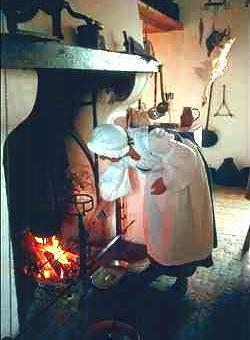
Introduction
The two primary reasons for building a fire are:
- To provide heat for your home.
- To provide a convenient place to cook food from scratch or to heat food from a can.
Firewood
To build a fire you will need firewood.
You have two options for acquiring your firewood as follows:
- Purchase Your Firewood From Someone Else: If you purchase your firewood and only split firewood is available, then you will have to purchase what is available. But you might ask your firewood supplier if there is a price difference between split and unsplit logs. If there is a big price difference, then the next question would be the average size of the unsplit logs. If the average size is what you can burn in the Texas Fireframe (discussed later in this article), then you could save some money by purchasing the unsplit logs instead.
- Cut Your Own Firewood: If you decide to cut your own firewood then may I please offer the following advice. After you have the tree safely on the ground, leave it alone for at least six to eight weeks. Most people want to start cutting on the tree immediately but that is not the best way to cut firewood. If you will leave all the limbs on the tree, and the top on the tree, then they will suck the moisture (sap) to the tips of the branches and this will help to quickly dry out your recently downed tree. After waiting about two months you will discover that the wood is reasonably dry and it doesn't weigh very much because most of the moisture in the wood is now gone. However, if you start cutting the tree into firewood size lengths immediately after you cut the tree down, then the moisture will be trapped in each piece of firewood and it will take a lot longer for those pieces to dry in the sun.
Chainsaw Safety: A chainsaw is an excellent tool that can be used to cut down trees and to cut firewood to the proper length. However, it can also cripple or kill you if you are not extremely careful with it. Before you begin cutting your own firewood you should receive proper instructions on the safe way to cut down a tree and the safe way to use a chainsaw to cut firewood.
Gas or Electric Chainsaw: There are advantages and disadvantages of both gas and electric chainsaws. If you have solar panels and some deep-cycle batteries and a 120-volt inverter and some 100-foot long electrical extension cords, then I recommend the electric chain saw with a 16-inch long blade. You simply push the button to start the saw and release the button to stop the saw. At my age this is a significant advantage. You will need to make your own decision about which type of chain saw would be best for your specific application.
Splitting Firewood: In my opinion it is much easier to split firewood with a steel wedge and a sledgehammer than with an axe. Place the tapered end of the steel wedge against the upright end of the log and tap it into place with the head of the sledgehammer. Then continue striking the steel wedge with the head of the sledgehammer to split the log into firewood. Extremely wide logs may need to be split into quarters or sixths or eights.
Stacking Firewood: Do not stack your firewood directly on top of the ground. The moisture in the ground will attack your firewood and your stack of firewood will gradually begin to rot. Before you begin stacking your firewood put two long sticks on the ground from side to side in the spot where you wish to stack your firewood. The sticks can be about one or two inches in diameter and the length of your intended stack of firewood. If you don't have any sticks then you can use pressure treated 2x4 lumber instead. Then stack your firewood on top of the two long sticks or 2x4s. By elevating your firewood a short distance off the ground the air will be able to circulate below your firewood and help to keep it dry, and the ground moisture will only attack the two sticks that are making direct contact with the ground.
Protecting Firewood from the Rain: Stack your firewood under a shed or porch, or cover your firewood with a tarp or an old shower curtain. Then buy a new shower curtain for your bathroom.
Length of Firewood Logs
The maximum length of your firewood logs will depend on the size of your fireplace or the size of your cast iron stove.
The maximum log length should allow air to properly circulate around the outside of your logs while they are burning. The burning logs should not make direct contact with the inside walls of your fireplace or the inside walls of your cast iron stove.
A firewood log that is too short can still be successfully used. However, a log that is too long will not fit in your fireplace or stove. Therefore it is better to have firewood that is shorter than to have firewood that is too long to be used.
On the other hand, if you are cutting your own firewood and you cut your firewood a lot shorter than it needs to be then you will be investing more time and energy in cutting your firewood than necessary. Therefore you should determine the correct log length you will need and then cut your firewood to that length or an inch or two shorter.
Fireplace: The maximum log length should be at least four-inches shorter than the interior width of your fireplace at its rear. In addition, the cut firewood should not extend more than two-inches off each end of your cast iron grate or Texas Fireframe. In other woods, measure the length of your grate or Fireframe from left to right and add four-inches to that value to arrive at the maximum firewood log length. However, if you will be using your fireplace to cook your meals, then the maximum length of the firewood logs should not exceed the length of your grate or Fireframe from left to right. The reason for this will be explained later in this article when cooking with firewood is discussed in detail.
Cast Iron Stove: The maximum log length should be at least eight-inches shorter than the inside length of your cast iron stove from front to rear. You do not want to have part of your fire burning directly below the stove pipe vent at the rear of your stove because that heat will rise directly up the vent and disappear outside your home. This would be wasteful. If you follow my recommendation later in this article and you install a cast iron grate on the inside bottom of your cast iron stove, then the maximum length of your logs should be the length of your cast iron grate. In general, the logs should not be longer than the distance from end to end of the burners directly above the fire area.
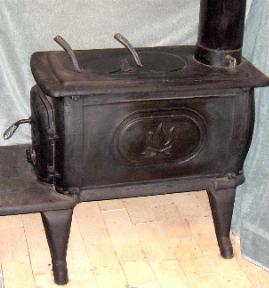
Cast Iron Stove and a Cast Iron Grate
Curing a New Stove or a Used Stove: Wipe the cast iron stove clean of dust and dirt. If necessary use a little soap and water to remove any surface stains. Completely rinse the soap off the stove and then carefully dry the stove. Cover the entire outside of the stove and attached stovepipe with a very, very thin layer of extra virgin olive oil or cooking oil or melted shortening or melted animal fat. Then start a very small fire inside the stove and allow the fire to heat the cast iron so the excess oil melts off the stove and what remains is cured into the cast iron itself. Allow the stove to cool and then inspect the exterior surface carefully to make sure you didn't miss any spots. If you missed one or more spots the first time then repeat the process and make sure you cover any spots you originally missed.
Cast Iron Grate: I recommend that you purchase and install a cast iron fireplace grate in the bottom of your cast iron stove. This would be the same type of grate you would use in a conventional wood burning fireplace. Before you invest in one of these cast iron grates you should measure the diagonal opening at the front of your cook stove to determine the maximum clearance available for inserting a cast iron grate. Place your logs on this grate and start your fire. The grate will allow air to circulate below and around the outsides of your logs to produce a superior fire inside your cast iron stove.
Wood Burning Fireplace and a Cast Iron Grate
You will need a cast iron grate or a Texas Fireframe (discussed later in this article) if you are using a wood burning fireplace. The grate elevates the firewood off the bottom of the fireplace and it allows air to circulate around the logs as they are burning to yield a better fire. A grate or Fireframe should be placed about one-inch from the rear of the fireplace and at least one-inch from the side of the fireplace. The side clearance will depend on the size of the grate in relation to the length of the firewood you will be using. Whenever possible the grate should be centered below your firewood so an equal amount of each log extends off the left and right sides of the grate. The ends of the firewood logs should be at least one-inch or more from the sides of the fireplace.
You have two options for selecting the optimal size of cast iron grate as follows:
- Purchase the largest cast iron grate you can find but which still leaves one-inch of clearance from the grate to the rear of the fireplace, and one-inch of clearance on both the left and right sides of the grate and the walls of the fireplace. This grate should then be positioned in the center of your fireplace and left there when heating your home with firewood, or when cooking a meal inside your fireplace.
- Purchase a cast iron grate that is approximately one-half the width of the inside of your fireplace from left to right and which still leaves one-inch of clearance from the rear of the grate to the rear of the fireplace. Place the grate on the left side of the fireplace about one-inch from the left wall of the fireplace. Build a normal fire on the grate and wait for the wood to burn down into red hot coals. The red hot coals should fall through the openings in the grate onto the floor of your fireplace. Then use a steel fireplace poker to slide the cast iron grate from the left side of your fireplace to the right side of your fireplace. Leave about one-inch of clearance from the right side of the grate to the right wall of the fireplace. Then place a folding campfire grill inside your fireplace on the left side above the red hot coals. You can then use cast iron cookware to cook your meals on top of the campfire grill on the left side of your fireplace. While your meal is cooking you can start a new small fire on the cast iron grate on the right side of the fireplace. This method will allow you to shift the cast iron grate back and forth from left to right and from right to left inside your fireplace whenever you need red hot coals to prepare a meal. If you don't need to cook then you can leave the cast iron grate in its current position to support your firewood while you heat your home with a normal fire.
Texas Fireframe
(May be purchased at: www.texasfireframe.com)
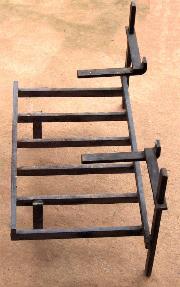 The Texas Fireframe was invented by Lawrence Cranberg, Ph.D. for use in a wood burning fireplace. It is made of heavy-duty steel. The bottom part of the Fireframe looks very similar to a standard cast iron grate that you would use in a conventional wood burning fireplace. However, the Fireframe has two vertical steel front supports, one on the left side of the lower grate and one on the right side of the lower grate. Attached to each of these two vertical steel supports is another piece of steel that extends horizontally about 1/4 of the way across the front of the grate and then they turn at a 90-degree angle and continue about 1/2 of the distance above the lower grate. These two horizontal pieces can slide up and down the vertical steel supports.
The Texas Fireframe was invented by Lawrence Cranberg, Ph.D. for use in a wood burning fireplace. It is made of heavy-duty steel. The bottom part of the Fireframe looks very similar to a standard cast iron grate that you would use in a conventional wood burning fireplace. However, the Fireframe has two vertical steel front supports, one on the left side of the lower grate and one on the right side of the lower grate. Attached to each of these two vertical steel supports is another piece of steel that extends horizontally about 1/4 of the way across the front of the grate and then they turn at a 90-degree angle and continue about 1/2 of the distance above the lower grate. These two horizontal pieces can slide up and down the vertical steel supports.
The Texas Fireframe in the picture on the right is 25" long from left to right, 13.5" wide from front to rear, and 15" high from bottom to top. The lower log grate is 20.5" long by 13" wide and it is 6" high off the ground at the front and rear, 5" off the ground on the left and right, and it has 4" of clearance below the grate. The upper support arms are 7.25" long from front to rear, with a open gap space of 11" between the upper left and right support arms. If you will measure the opening inside your current fireplace then you should be able to determine if the Texas Fireframe will fit inside your existing fireplace.
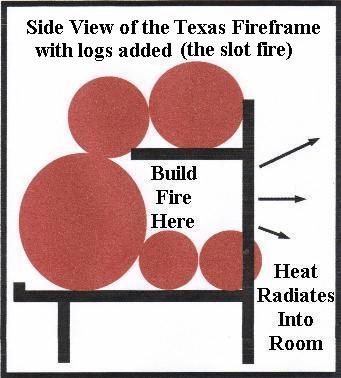 To build a fire on the Texas Fireframe you put your biggest log (about 6 inches in diameter) on the rear of the Fireframe. You then put two or three smaller diameter logs (2" or 3" diameters) on the lower grate. Then you finish with one or two logs (3" to 5" diameters) on the upper support arms. The result is that you have created a "C" shaped pattern using your logs with the open part of the "C" facing into your home. You then put a few sheets of crumbled newspaper into the open area between the upper and lower logs and light the newspaper. A few minutes later the upper logs will start burning and then the other logs will start burning and you will have a nice fire in your fireplace. But because of the "C" shape of your fire a significant amount of the heat generated by the fire will be directed out of the fireplace into your home.
To build a fire on the Texas Fireframe you put your biggest log (about 6 inches in diameter) on the rear of the Fireframe. You then put two or three smaller diameter logs (2" or 3" diameters) on the lower grate. Then you finish with one or two logs (3" to 5" diameters) on the upper support arms. The result is that you have created a "C" shaped pattern using your logs with the open part of the "C" facing into your home. You then put a few sheets of crumbled newspaper into the open area between the upper and lower logs and light the newspaper. A few minutes later the upper logs will start burning and then the other logs will start burning and you will have a nice fire in your fireplace. But because of the "C" shape of your fire a significant amount of the heat generated by the fire will be directed out of the fireplace into your home.
I purchased a Texas Fireframe Grate in 1999 and I have used it in my home every winter since then. The Fireframe uses no electricity and it will fit into any standard size fireplace. And it really does significantly increase the amount of heat that is actually transmitted into my home from the burning logs.
When the fire has completely burned itself out then there will be a pile of ashes in the bottom of the fireplace. That pile of ashes looks exactly the same regardless of whether you are using unsplit logs or split firewood.
When the significance of this sinks in, you quickly realize that unless there is a good reason to split your firewood, then you are simply investing extra labor that yields no positive return. (Unless you need the exercise and you have absolutely no other manual chores to do.) Therefore any system that can provide a good fire using unsplit logs is a real time and energy saver.
In my opinion there are four major advantages to the Texas Fireframe:
- Heat: You get a lot more heat into your home from the burning logs and it doesn't require any electricity or a fan.
- Unsplit Logs: You can use unsplit logs. This is a major factor for me. Cutting down a tree and then cutting it into firewood lengths is only part of the job. If you then have to split each of the logs, you expend a lot more effort. And if you are trying to conserve your energy, then splitting logs is not the way you want to spend your time.
- Easy Fire Starting: The unsplit logs can easily be lit with a few sheets of newspaper rolled up and placed in the center cavity between the logs. Until you actually do it, you probably will not believe this is possible. With a regular fireplace grate you need newspaper and lots of small tiny sticks or kindling to start the fire. Then you gradually add slightly bigger sticks until the fire is burning well enough that you can start putting your split firewood on the fire. None of this kindling is necessary with the Texas Fireframe. And a really good fire is heating your home in about 15 minutes instead of 30 minutes (or longer).
- Low Risk of a Chimney Fire: The risk of a chimney fire is very close to zero with a Texas Fireframe grate. If you are forced to use a wood burning fireplace as a primary source of heat for an extended period of time, it would be nice to feel safe that your home isn't going to burn down as a result of a chimney fire.
The major disadvantage of the Texas Fireframe is its initial cost. However, the Texas Fireframe is made of very sturdy material, as opposed to the normal fireplace grates you typically find in the hardware stores. Over the years I have burned up and replaced several of those cast iron grates. After ten years of using my Texas Fireframe on an intermittent basis each winter, I can't see any damage anywhere on the entire unit (a picture of my Texas Fireframe was shown above). My guess is that my Fireframe will easily last another 10 or 15 years or maybe longer. Therefore, if you consider the replacement cost of a cast iron grate every five to seven years, the cost of the Texas Fireframe grate is probably about the same as several cast iron grates over a 20 to 25 year time period. And when you factor in the difference in price (or labor savings) from unsplit logs, then the Texas Fireframe is clearly a lower cost option over the long run.
I can personally verify that the statements made by Dr. Lawrence Cranberg regarding the operation and efficiency of the Texas Fireframe Grate are not overstated. A very comfortable fire can be started on the Texas Fireframe Grate using unsplit logs and a few sheets of newspaper. The resulting fire burns well and a significant amount of the heat from the fire enters the room and does not disappear up the chimney.
Normally I use the approximate size logs that are recommended for the grate. I always place the biggest log I have available on the rear of the grate. However, as I burn through my firewood each winter, I sometimes use two medium logs on top (instead of one), and three smaller logs on the bottom (instead of two). Even with these minor changes, the grate still provides a significant amount of heat for my home. I have occasionally used split firewood and that also does exceptionally well on the grate.
Cast Iron Cookware
 Cast iron cookware is the recommended cookware for use on a cast iron stove or inside a wood burning fireplace. Cast iron cookware is 100% cast iron and it does not contain any parts that are made of plastic or aluminum or wood that could melt or catch fire when exposed to the intense heat of a wood burning fire.
Cast iron cookware is the recommended cookware for use on a cast iron stove or inside a wood burning fireplace. Cast iron cookware is 100% cast iron and it does not contain any parts that are made of plastic or aluminum or wood that could melt or catch fire when exposed to the intense heat of a wood burning fire.
I suggest you purchase cast iron cookware with a lid for two reasons:
- The lid will keep embers and ashes and soot from getting into your food inside the cook pot.
- The lid will keep more of the heat and the flavor of the food inside the cook pot which will minimize the amount of firewood needed, reduce the total time required to cook the food, and maximize the flavor of the finished food.
Some cast iron cookware, such as a Dutch Oven, is sold with the lid as part of the unit. However, most of the other cast iron pieces are not sold with a lid. Instead a lid must be purchased separately. I strongly recommend that you purchase a lid for each piece of cast iron cookware that you acquire.
For additional information about cast iron cookware please read my article on my web site about how to cook with cast iron and how to take care of cast iron cookware.
Stainless Steel Cookware and
Teflon Coated Cookware
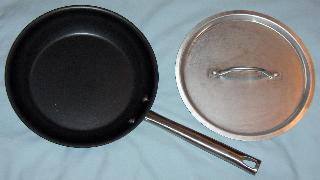 If you can find 100% stainless steel cookware without any plastic parts then it could be used to cook over a wood burning fire.
If you can find 100% stainless steel cookware without any plastic parts then it could be used to cook over a wood burning fire.
A stainless steel skillet cover may be used to cover your pots and skillets and it can be safely used with a wood burning fire.
Some stainless steel cookware if very cheaply made and it will not last very long in any type of cooking application.
The advantage of cast iron cookware over stainless steel cookware is that food will usually not stick to the inside of the cast iron cookware.
Cookware that has a Teflon coating on its interior cooking surface can be used with a wood burning fire if the rest of the cookware is made of heavy-duty metal and it does not contain any aluminum or have any plastic or wood handles. This type of cookware can sometimes be found in the camping section of a sporting goods store, or an Army-Navy store, or a WalMart.
Suggestions for Cooking
on a Cast Iron Stove,
and in a Conventional Fireplace,
and using the Texas Fireframe
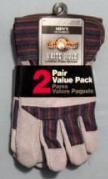 You will need a pair of heavy-duty leather gloves with loose fitting wrists to cook inside a fireplace or over a cast iron oven. The loose fitting wrists will allow you to quickly shake the gloves off your hands if the gloves accidentally become too hot from the fire or a cast iron skillet.
You will need a pair of heavy-duty leather gloves with loose fitting wrists to cook inside a fireplace or over a cast iron oven. The loose fitting wrists will allow you to quickly shake the gloves off your hands if the gloves accidentally become too hot from the fire or a cast iron skillet.
Do not cook over the flames of a wood fire. Instead wait for the wood to burn down into red hot coals and then cook over the red hot coals. This is the same basic principle as cooking over charcoal.
Cast Iron Stove: Cast iron cookware is easy to use on a cast iron stove. Simply place the cookware on the top burners to cook your food. Or use lid lifters to remove the burner covers and place your skillet directly above the fire inside the stove.
Cast Iron Stove Burner Lids: If you put your skillet on top of the burner lids then the lid itself will capture and retain some of the heat and less heat will be transferred to the bottom of the skillet and it will take longer to cook your meal. However, sometimes you only want to keep food or water "warm" and the best way to do this is to leave the lid on the stove between the fire and the bottom of the skillet or cook pot. On the other hand, if you remove the burner covers with a lid lifter and then place your skillet directly above the opening into the stove, then more of the heat from inside the stove will make contact with the bottom of your cast iron skillet. This will result in less time being required to cook whatever you have in your skillet. However, for this to work the diameter of the bottom of your skillet needs to be at least 1-inch wider than the diameter of the round opening on top of the stove.
Wood Burning Fireplace: In a conventional fireplace you should wait for your firewood to burn down into red hot coals. Then you have several options as follows:
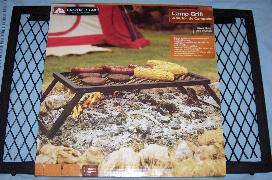
- Cast Iron Dutch Oven: Place a "Dutch Oven" directly on top of your cast iron grate above the red hot coals, or move the grate and place the Dutch Oven on top of the red hot coals.
- Charcoal Flat Metal Grill Surface: Place a charcoal metal grill surface across the top of your cast iron grate inside your fireplace. Then you can cook with a cast iron skillet on top of this flat metal grill surface.
- Folding Campfire Grill: If you purchased a cast iron grate that is about one-half the width of your fireplace, then you could move the cast iron grate to the other side of the fireplace as described earlier in this article. Then put a folding campfire grill over the red hot coals and then you can cook on the surface of the campfire grill.
- Pot Hook: You can hang a pot with a wire handle from a hook that swings into and out of the fireplace.
Texas Fireframe: If you are using a Texas Fireframe, then after the logs have burned down into red hot coals you have two options as follows:
- Cast Iron Dutch Oven: Place your food inside a cast iron Dutch Oven with a lid and place the Dutch Oven on top of the lower part of the Texas Fireframe directly above the red hot coals.
- Cast Iron Skillet: Place your skillet directly on top of the lower cooking grate and cook your meal inside your skillet. Or place a charcoal metal grill surface across the lower part of the Texas Fireframe. After you have positioned your metal grill in its most advantageous position then you can place a skillet on the metal grill surface and cook your meal.
Respectfully,
Grandpappy.
Grandpappy's e-mail address is: RobertWayneAtkins@hotmail.com






































 The Texas Fireframe was invented by Lawrence Cranberg, Ph.D. for use in a wood burning fireplace. It is made of heavy-duty steel. The bottom part of the Fireframe looks very similar to a standard cast iron grate that you would use in a conventional wood burning fireplace. However, the Fireframe has two vertical steel front supports, one on the left side of the lower grate and one on the right side of the lower grate. Attached to each of these two vertical steel supports is another piece of steel that extends horizontally about 1/4 of the way across the front of the grate and then they turn at a 90-degree angle and continue about 1/2 of the distance above the lower grate. These two horizontal pieces can slide up and down the vertical steel supports.
The Texas Fireframe was invented by Lawrence Cranberg, Ph.D. for use in a wood burning fireplace. It is made of heavy-duty steel. The bottom part of the Fireframe looks very similar to a standard cast iron grate that you would use in a conventional wood burning fireplace. However, the Fireframe has two vertical steel front supports, one on the left side of the lower grate and one on the right side of the lower grate. Attached to each of these two vertical steel supports is another piece of steel that extends horizontally about 1/4 of the way across the front of the grate and then they turn at a 90-degree angle and continue about 1/2 of the distance above the lower grate. These two horizontal pieces can slide up and down the vertical steel supports. To build a fire on the Texas Fireframe you put your biggest log (about 6 inches in diameter) on the rear of the Fireframe. You then put two or three smaller diameter logs (2" or 3" diameters) on the lower grate. Then you finish with one or two logs (3" to 5" diameters) on the upper support arms. The result is that you have created a "C" shaped pattern using your logs with the open part of the "C" facing into your home. You then put a few sheets of crumbled newspaper into the open area between the upper and lower logs and light the newspaper. A few minutes later the upper logs will start burning and then the other logs will start burning and you will have a nice fire in your fireplace. But because of the "C" shape of your fire a significant amount of the heat generated by the fire will be directed out of the fireplace into your home.
To build a fire on the Texas Fireframe you put your biggest log (about 6 inches in diameter) on the rear of the Fireframe. You then put two or three smaller diameter logs (2" or 3" diameters) on the lower grate. Then you finish with one or two logs (3" to 5" diameters) on the upper support arms. The result is that you have created a "C" shaped pattern using your logs with the open part of the "C" facing into your home. You then put a few sheets of crumbled newspaper into the open area between the upper and lower logs and light the newspaper. A few minutes later the upper logs will start burning and then the other logs will start burning and you will have a nice fire in your fireplace. But because of the "C" shape of your fire a significant amount of the heat generated by the fire will be directed out of the fireplace into your home. Cast iron cookware is the recommended cookware for use on a cast iron stove or inside a wood burning fireplace. Cast iron cookware is 100% cast iron and it does not contain any parts that are made of plastic or aluminum or wood that could melt or catch fire when exposed to the intense heat of a wood burning fire.
Cast iron cookware is the recommended cookware for use on a cast iron stove or inside a wood burning fireplace. Cast iron cookware is 100% cast iron and it does not contain any parts that are made of plastic or aluminum or wood that could melt or catch fire when exposed to the intense heat of a wood burning fire. If you can find 100% stainless steel cookware without any plastic parts then it could be used to cook over a wood burning fire.
If you can find 100% stainless steel cookware without any plastic parts then it could be used to cook over a wood burning fire. You will need a pair of heavy-duty leather gloves with loose fitting wrists to cook inside a fireplace or over a cast iron oven. The loose fitting wrists will allow you to quickly shake the gloves off your hands if the gloves accidentally become too hot from the fire or a cast iron skillet.
You will need a pair of heavy-duty leather gloves with loose fitting wrists to cook inside a fireplace or over a cast iron oven. The loose fitting wrists will allow you to quickly shake the gloves off your hands if the gloves accidentally become too hot from the fire or a cast iron skillet.

